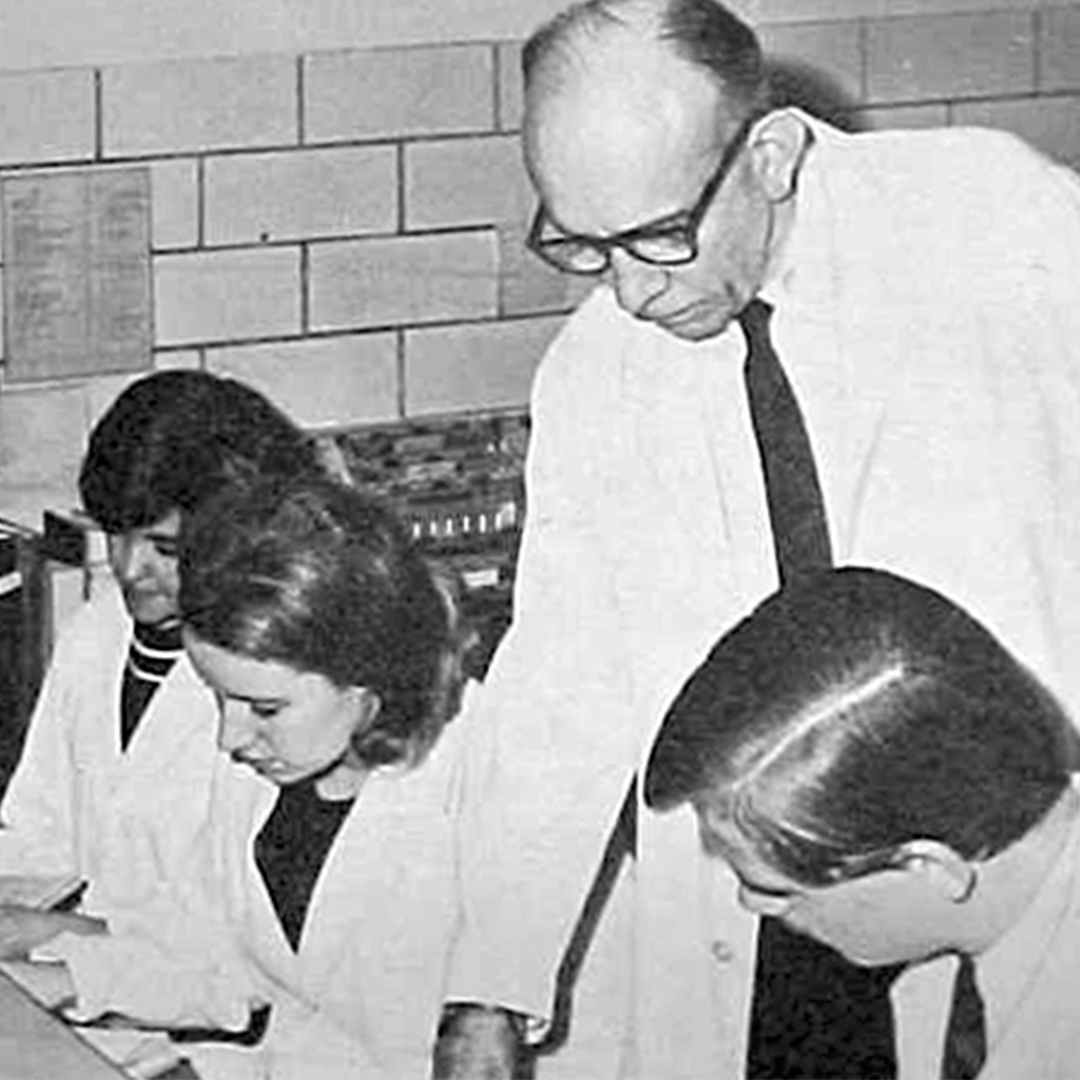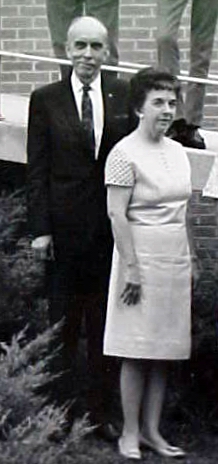Dr. Hu C. Myers (1902-1987) established the first baccalaureate degree program for Physician Assistants (PAs) at Alderson-Broaddus College in Philippi, WV in 1968. Besides being a surgeon of the highest caliber, Dr. Myers lead the Myers Clinic Hospital, held state related offices, and developed nursing and allied health education programs at Alderson-Broaddus College.
He was born on March 29, 1902, in Nestorville, West Virginia as the second child of Dr. and Mrs. Jehu Winfred (J.W.) Myers. After graduating from Broaddus Academy in Philippi, WV in 1920, he entered West Virginia University in Morgantown, WV. Although his father was a general practitioner, Myers worked to help pay his school expenses. He sold war bonds and blankets to pay his tuition and worked as a steward at his fraternity house (Kappa Psi medical fraternity) for his board and meals. He received a BS degree in medicine in 1924. His main extracurricular activity was playing the trumpet in the school’s band.
An acute illness during the summer of 1924 kept him from immediately attending the University of Cincinnati’s Medical School and forced him to look for a school located in a “warmer climate.” So he applied the following year and was accepted at the Emory University School of Medicine, Atlanta, GA. After receiving his MD from Emory University in 1927, Myers received surgical training at the Steiner Clinic and Georgia Baptist Hospital as well as Columbia University. In between training sessions and on school holidays and vacations, he worked as a general practitioner in Philippi, WV. With his surgical training completed, he joined his father Dr. J.W. Myers and his physician brother Dr. Karl Myers to establish in 1933 the Myers Clinic-Hospital in Philippi.
In the early 1940’s, Dr. Hu (as he became affectionately known) spearheaded the establishment of the first degree-granting nursing program in West Virginia. His initial plan was to house the nursing program in a new hospital located on the Alderson-Broaddus campus but due to difficulties securing the funding for the facility, the nursing program commenced in 1945 at the Myers Clinic-Hospital. He, other physicians and nurses at the Myers Clinic-Hospital served as the initial faculty. With the assistance of the Hill-Burton Act, his dream of erecting a hospital on College Hill finally became a reality with the opening of Broadus Hospital in 1954.
As a native West Virginian, the son of a physician, and a doctor who trained, practiced and traveled throughout the United States and the world, Dr. Hu knew first hand the discrepancies in the quality and delivery of health care for individuals residing in rural underserved areas and those living in urban settings. He firmly believed that access to quality, basic health care should be a right of every American citizen. But his rural background and diverse health care experiences also made him acutely aware of the multitude and complexities of problems associated with recruiting and retaining an adequate supply of physicians to meet this demand. As a visionary and realist, he and a small group of physicians at the time believed that it didn’t necessarily take a physician to provide all the needed health care services. He felt that an “assistant” to work with the physician to perform routine, delegated tasks was appropriate. However, he also felt that these “physician’s assistants” would have to be adequately trained in both the art and science of medicine to be accepted by the physician and health care community as well as the patients.
Two years after Dr. Hudson’s controversial editorial calling for the training of doctor’s assistants that appeared in JAMA in 1961 and two years before Dr. Stead started the Duke University Physician Assistant Program in 1965; Dr. Hu approached the administration of Alderson-Broaddus College with his proposal to establish a new type of health care provider training program at their facility. The College’s Board of Trustees finally approved in 1967 Dr. Hu’s innovative concept to be the first PA program in the Country to offer a 4 year curriculum that awarded a bachelor degree upon completion and be established at a liberal arts college and not at a medical school. The program would not require its students to have previous health care experience and would accept them directly from high school. The Board of Trustees did place however three caveats on its approval. First, Myers had to get the approval of organized medicine. Second, he had to obtain adequate funding from alternative sources. And finally, the faculty had to approve the completed program.
To many, these hurdles may have seemed “impossible” to surmount. But Dr. Hu had been doing his “homework” over the past 4 years, establishing relationships, responding to concerns, promoting his concept, forming advisory councils, and working with leaders from the AMA, WVSMA and the State Nursing Association to win their support. He had been in communication with the Commonwealth Fund, Robert Wood Johnson Foundation and the NIH about funding the program. And, he had been working with the college’s senior faculty and administration to ensure they understood and supported the development of the PA program. All the necessary pieces came together and in the fall of 1968, the first PA class enrolled at the College. By the time the first class graduated in 1972, Alderson-Broaddus College joined four other PA programs to be the first to gain full accreditation by the American Medical Association.
Dr. Hu served as medical director and an instructor for the PA program from its inception until his retirement in 1977. He continued to accept and precept second and third year PA students in the clinic until 1983 when he ended his practice of medicine. From that point forward, he did research and wrote papers on his lifetime interest in the causes and treatment of lower back pain. He died at home on December 15, 1987 and was buried at the Mt. Vernon Cemetery in Philippi, WV.
As the old adage goes, ‘behind every successful man, is a great woman’, was definitely true in Dr. Hu’s case. In fact, he himself admitted it. In dedication of his book, The Physician’s Assistant: A Baccalaureate Curriculum, to his wife, he had the following to say regarding her, “Avanelle, a real pioneer in the development of a high-level education for those who are to play a valuable part in modern medicine. Her close association with medical practice through her adult life as a physician’s wife, counselor, and president of the Auxiliary to the West Virginia State Medical Association gave her a unique understanding of the possibilities and the pitfalls in the planning, development, and operation of the Alderson-Broaddus College Physician’s Assistant Program, where she served efficiently as the educational coordinator.”
Acknowledgment: This Biographical Sketch was prepared by Pamela Moyers Scott, MPAS, PA-C and Michael Holt, MS, PA for the Society for the Preservation of Physician Assistant History. The photographs are from a collection maintained by the PA Program, Alderson-Broaddus College and are reproduced with the permission of Alderson-Broaddus College.
(December 15, 2004)
When using information from this biography, please provide the proper citation as described within the PA History Society Terms of Use.





